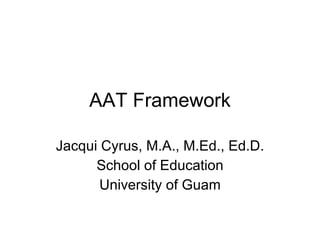AAT Frameworks
- 1. AAT Framework Jacqui Cyrus, M.A., M.Ed., Ed.D. School of Education University of Guam
- 2. AT Frameworks - Overview SETT (Student, Environments, Tasks, and Tools) Provides a structure for collaborative groups to work together and think well about the AT devices and services that are needed to provide a student with disabilities access to education opportunities AF (Adaptations Framework) Used to help professionals decide the type of adaptations that would be the most beneficial
- 3. SETT Framework (1) the individual requires an adaptation, such as AT, to meet his/her needs; (2) the individual requires a different type of adaptation, including AT that what is presently being used;
- 4. SETT Framework - contâd (3) the individual does not need an adaptation to meet his or her needs at this time; or (4) further information is required and additional evaluation is necessary, which may include an AT evaluation.
- 5. Adaptations Framework Used for considering whether or not an individual can benefit from adaptations by asking a series of questions to facilitate decision making as the AF is implemented. Refer to AF handout.
- 6. Adaptations Framework Setting-Specific Demands: Tasks, Requisite Abilities, Functional Capabilities, Functional Limitations Adaptations Types, Person and Technology Match, Training
- 7. Adaptations Framework contâd Evaluation of Effectiveness Environmental Factors, Use of Device/Adaptation, Progress Independence Accessibility
- 8. Individual Tasks Develop your own Adaptations Framework chart for Sara, with which you will add additional components. This will be your case study.
- 9. Evaluation of Effectiveness of Adaptations Environmental Factors Use of Adaptations Monitoring User Progress
- 10. References Bryant, D. P. & Bryant B. R. (2003). Assistive Technology For People With Disabilities. Boston, MA: Allyn and Bacon. U.S. Congress. (1988). U.S. Congress, Public Law 100-406, Technology-Related Assistance for Individuals with Disabilities Act of 1988.










